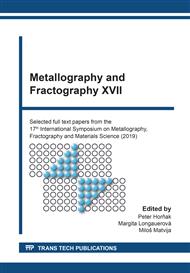p.26
p.33
p.43
p.48
p.54
p.60
p.66
p.75
p.80
Investigation of the Diffusion Couple Ductile Cast Iron / Iron
Abstract:
Forging of ductile cast iron with pure iron by the Damascus technique, results in a new composite material. The combination of cast iron and pure iron is unusual because of its rather different properties. After forging these two materials a small diffusion zone of about 150 µm was observed. Various heat treatments at 900 °C for 2, 4 or 20 hours and 950 °C for 4 h were performed to increase the diffusion zone up to 2.4 mm. At 900 °C carbon solubility in austenite is about 1.2 wt. % and at 950 °C 1.4 wt. %. During the heat treatment carbon diffuses from cast iron into the pure iron and the diffusion gradient grows with time and temperature. Furthermore, the samples were air cooled or water quenched. In the ductile cast iron, graphite nodules are surrounded by ferrite. During the heat treatment graphite is dissolved and pores are observed. In the diffusion gradient layer, a broad range of microstructures observed in hyper- and hypoeutectoid steels could be found. The microstructures were revealed by different etchants and moreover, hardness measurements were performed.
Info:
Periodical:
Pages:
54-59
Citation:
Online since:
November 2020
Authors:
Keywords:
Price:
Сopyright:
© 2020 Trans Tech Publications Ltd. All Rights Reserved
Share:
Citation:


